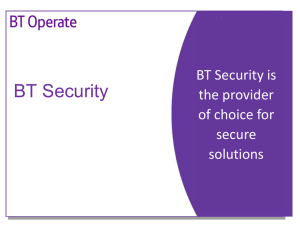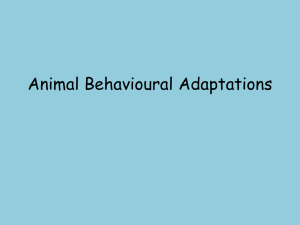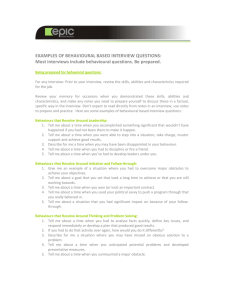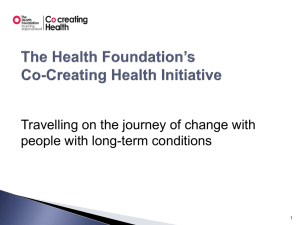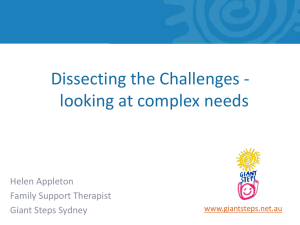Managing Challenging Behaviours - National Health Care for the
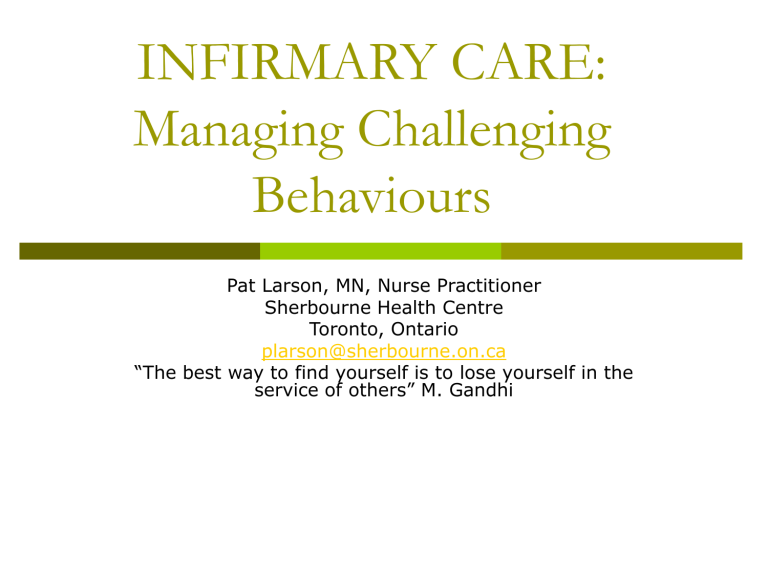
INFIRMARY CARE:
Managing Challenging
Behaviours
Pat Larson, MN, Nurse Practitioner
Sherbourne Health Centre
Toronto, Ontario plarson@sherbourne.on.ca
“The best way to find yourself is to lose yourself in the service of others” M. Gandhi
About this presentation….
Context
Behavioural Issues
Prevention/planning
Responding
Discussion
Context
Solutions are unique to the setting
We’re a learning environment...
Underpinning of values/principles
Pro-active/Prevention based stance
Responding “in the moment”
Your contribution to our development
An acknowledgement
Sherbourne Health Centre
Community based agency
Partnerships (ie. Naturopathy, chiropractic…)
Infirmary
Primary care programs
Homelessness
LGBTT community
Newcomers
Local community
Health Bus (volunteer RNs, outreach)
Sherbourne Health Centre Infirmary
Community-based, stand-alone model
20 beds (9 open at present)
Serves the Greater Toronto area
Referrals – self, community (shelters, drop-ins, community agencies and providers) and hospitals (~12 in area)
Opened April, 2007
Staffing Model
Community Health Worker (CHW) - 24/7
RN – 24/7
Case Manager
NP
Consulting MD
Manager and Admin Assistant
Partnerships (housing worker, pastor…)
Values/Principles
Program values
Social justice
Community/belonging courage
Harm reduction
Independence, self determination
Participation in program, health care plan
Trauma model
Kindness AND therapeutic value
Clients
Homeless/underhoused
Fractures, cardiac problems, diabetes, HIV, endocarditis, pneumonia, skin infections/cellulitis, osteomyelitis/bone infections, post surgically, post childbirth
Majority also have substance use issues
More men than women, but priorize women
Most leave to go to shelters; occasionally client is housed upon discharge
Referrals
Short term
Maximum stay 3 weeks; average ~ 10 days
Acute need
Written, faxed referral
Referee remains responsible for information transfer
Hospital visits w/ some referred clients
acuity ability to safely discharge clients
Behavioural Issues
Your setting
Your experiences?
Issues
Anything you would like to share?
Things we might address?
Preventing Behavioural Issues
Focus on referral
Adequate resources to process
Follow up with referees/client/supports
Ask difficult questions “are you barred?”
Program self-determination
Ability to say no to clients
Client meets program criteria?
Antennae on High Alert
Intent
Primarily - planning/managing
Consider - restriction
Shelter restrictions
Evidence or history of violent behaviours
Referee reluctant to provide information or details
Client vague/reluctant re details
Evidence of difficulty participating in previous programs
Planning with Clients
Contingency Planning
Frank
Involve community supports
Substance use
“How will you manage your cravings?”
“Do you plan to use? How could you reduce your use?”
History of Violence or Barrings
“What will be different in this program?”
Risk from Partners/others
Safety plan; involve management/security
Triggers
“What are your triggers? What is your plan to avoid? Manage?
Rights and Responsibilities
Discussions about
Expectations
Participation in program
Consequences of not respecting responsibilities
Independence
Contracts
Client developed
Staff developed
Harm Reduction
No illegal substances on-site
May use/imbibe, behaviour is the focus, not substance use
“What is your substance of choice?”
“How can we help you not to use? To use more safely? To use less while you’re ill?”
Trauma framework
Understanding and re-framing of people’s life experiences
Therapeutic responses
Self responsibility
Assist clients w/ coping strategies
Trauma of being discharged
Clients
Staff
Behaviours
Attempts to triangulate - “Manipulation”
Making unrealistic demands
“You’re not going to discharge ME, are you?”
Evasiveness
Not being honest
Not participating
Refusing to meet w/ providers, to get out of bed, have treatments….
Serious Adverse Behaviours
Disrespect - intolerance
Theft
Threats
Violence
Smoking inside/risk of fire
Substance use on the premises
Physical Environment
Clean, bright environment
Minimal sharing of bedrooms
Safe spaces, quiet areas
Able to go outside (smoke, appointments)
“This is the nicest place I’ve ever stayed.”
“I feel like I’m at the spa.”
On-site security
EMR – team care plans, rounds, reviews
Inclusive Environments
Diversity
How do we live it?
Social Inclusion
“Radical inclusion”
Respect, dignity
Ambivalent responses to acceptance
Resenting being cared for
Stepwise Approach
Accountability
First episode - not meeting responsibilities
Responsibilities, rules, consequences
Repeat behaviours
May result in discharge from program
Serious issues (violence/threats/theft)
Discharge from program,
? Charges?
Responding to Behaviours
All staff trained in Non violent Crisis
Intervention
Focus on understanding own responses
Minimal staffing levels
Timing of responses
In the moment
Can this wait? Should this wait?
Can this be ignored?
Issues of Responding
“Enforcer” role (“bouncer/security”…)
Who should respond to client?
Challenging particular behaviours
“I’m not feeling comfortable with ..”
“I need to speak with you about…”
Alone versus with support
Clarity
Consistent messages
Easier to say than do
Responding
Acknowledge client’s efforts and progress
Importance of humour
Staff training and support
Differences of opinions
Staff cohesiveness on the big issues
Recognizing when we’re inconsistent
Addressing our inconsistencies
Discussion
Thank you for the opportunity!
Feedback
Discussion


